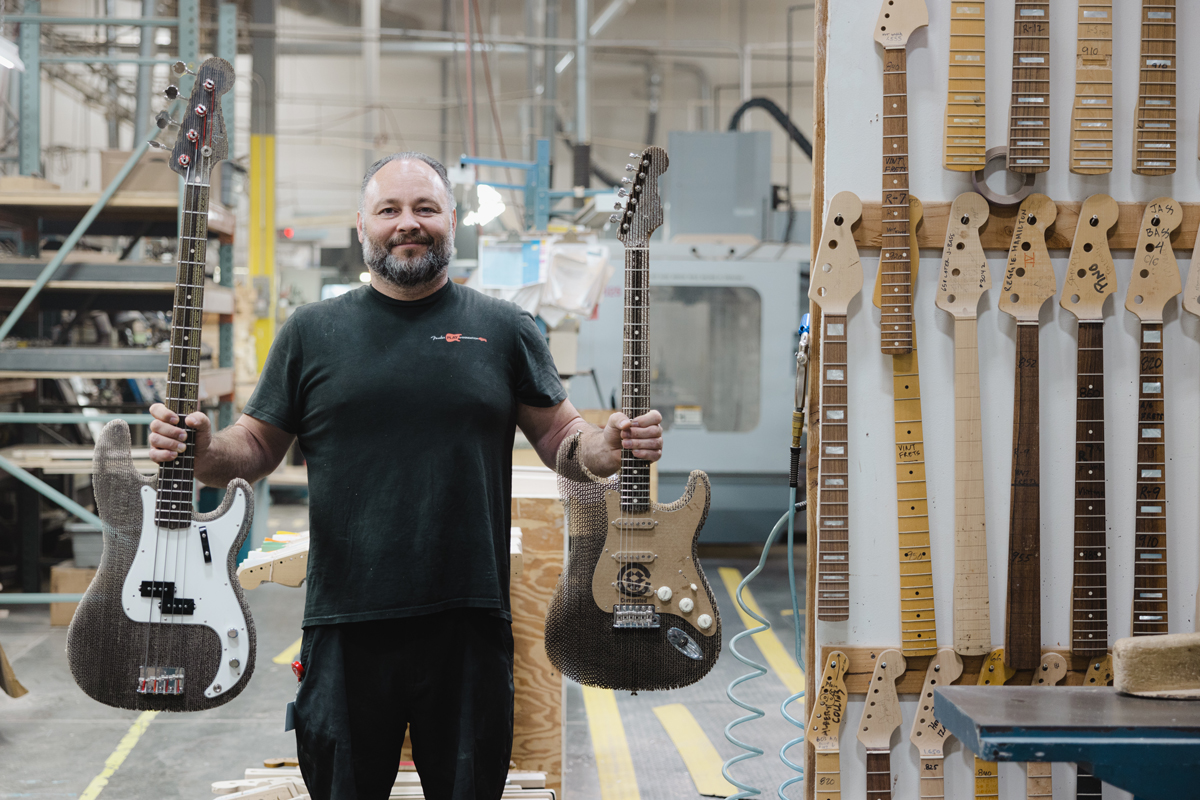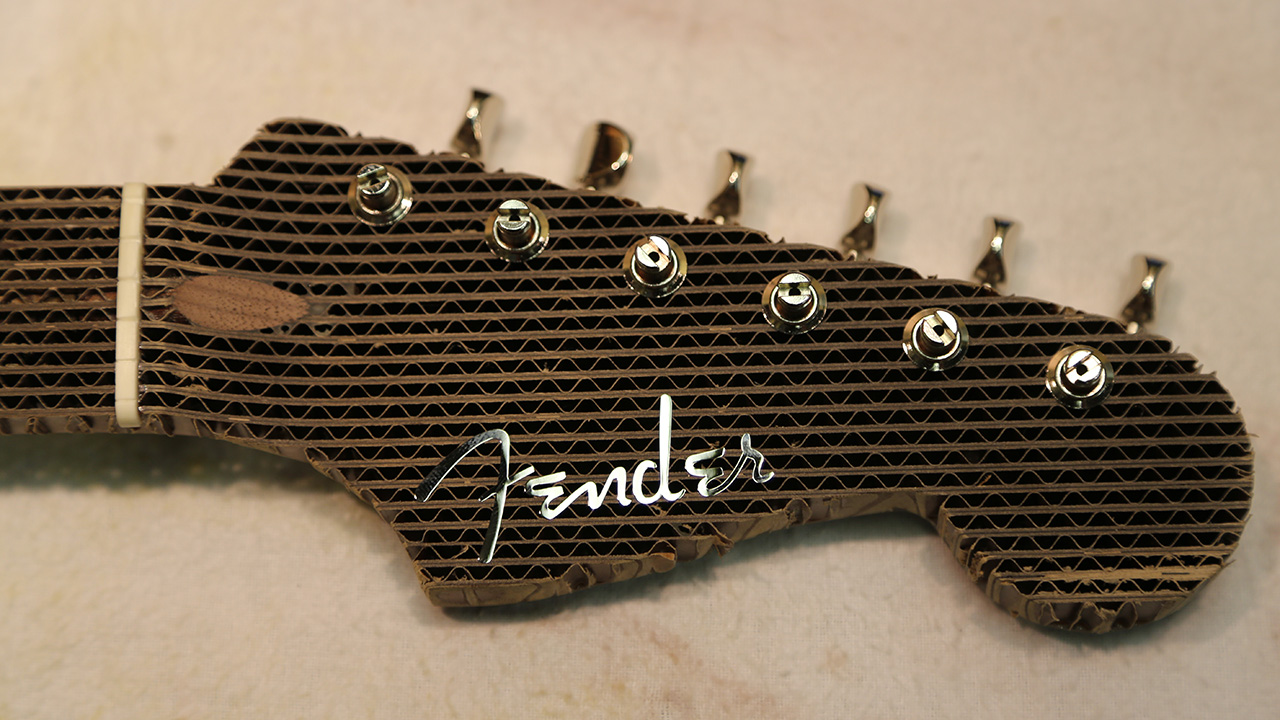“We had no idea it was going to perform the way it did – or if it was even going to be shown to anyone”: How Cardboard Sessions’ Dave Lee convinced Billy Gibbons, J Mascis and Keanu Reeves to slam on his Fender-approved cardboard guitars
Built by a Master Builder at Fender HQ, you can work the cardboard Strat hard and even whammy it – but you can also see right through it. Could this fun experiment be the future of guitar manufacturing?

Dave Lee understands the skepticism he faces when asking artists to participate in Cardboard Sessions, a recurring YouTube series that finds players squealing out leads on a fully functional yet primarily cardboard six-string.
The feeling changes when they start work with the awe-inspiring, Strat-style game-changer, which is Master-Built at Fender’s Corona, CA facility. Fit with hardware like a classic set of ’69 pickups and beveled like one of Leo’s legendary pieces, it’s not your standard solid body – you can literally see through its thousands of lightweight corrugated flutes.
And though it has more in common with an Amazon delivery box than your average alder-made S-shape, folks like Billy Gibbons, Dinosaur Jr.’s J. Mascis and LP manage to make Lee’s eccentric twanger sound fat as hell.
“A lot of artists will see the cardboard guitar for the first time and joke, ‘You guys just took some pizza boxes and started stacking them together to make a guitar!’” Lee says. He adds of the principles behind Cardboard Sessions: “What we’re doing is taking different types of cardboard – different types of flutes – and figuring out what’s going to be the best.”
Lee has plenty of experience redefining the DNA of our favorite playthings. Around 2008, the pro snowboarder’s Signal Snowboards company began building one-of-a-kind oddities to show off on YouTube. They included a glass snowboard, as well as a rideable/riffable bass-board with functional pickups set between its boot bindings. Duff McKagan test-rode its action before Lee and co. took it to the hills.
Signal later partnered with California’s Ernest Packaging for the Cardboard Chaos series, billed as a place “where progressive concept ideas in sports and music are crafted from cardboard.” Concepts included cardboard snowboard ramps – and in 2015, the first-ever cardboard Strat.
If you’re still suspicious of how the thing actually works, you may not be alone, but just check how it sings through the last years’ worth of cardboard sessions. The likes of Keanu Reeves’ Dogstar, Hot Snakes’ John Reis, and math-rock adventurists Battles have been jamming on the growing pool of corrugated guitars, P-basses, drum kits and more.
Get The Pick Newsletter
All the latest guitar news, interviews, lessons, reviews, deals and more, direct to your inbox!
Speaking with Guitar World, Lee talks us through surprisingly durable builds and – as Billy Gibbons recently sung in his session with former Guns ‘N Roses drummer Matt Sorum – why it’s high time we start “slamming on a cardboard guitar”.
Why did you start off with a Strat shape for this project? Were you fiddling around with any other classic body ideas?
“It was S-shape all the way. I’m a guitar player; I have a Fender Strat. We also just happened to know an amazing Master Builder over there who was excited to build this thing and see if it would work. Honestly, we had no idea that it was going to perform the way it did, or if it was even going to be shown to anyone.”
What was it like to see the first cardboard guitar come together in Corona?
“Because of the fragility of cardboard, Paul Waller, the Master Builder there, hand-shaped it. We were able to go into this room where you could pull the Strat template from the ‘60s, and basically put in this block that’s cuts into the Strat shape. Then you’d hand-sand it. That’s how they used to be done back in the day, before there were CNCs.
“When we gave Paul our block of cardboard, all those beautiful curves of a Strat were laid into it – it was rounded perfectly. You could see the corrugated paper flaking around the sides, and then you could twist the body and see through it. Dude, we were all just blown away. All we wanted to do was make something that was sturdy enough to be able to handle the tension from the strings.”

Do you have to be precious with this instrument, or can you just rock it like a good old Strat?
“The first one we made was pretty delicate. It was completely cardboard; we didn’t fill in the neck with the eco-resin that we now use. So, you were bending notes and you could feel those flutes.
“After they get played a lot, or if they’re sitting in Palm Springs and it’s super-hot, things change. That material is not as sturdy as wood, obviously, so there are some minor tweaks that need to happen.
“But they all have truss rods; you’re able to tweak ’em. The structural integrity is pretty amazing for cardboard. You can totally rock it. If you watch the episode with Jordan Cook from Reignwolf and Brad Wilk, I thought that guitar would never work again after Jordan held it – he put it through its paces.”
Your Strat is mounted with the classic hardware, including a traditional bridge. I haven’t seen someone use a whammy bar on one of these sessions…
“You can use one. It’s just no-one’s actually chosen to.”
As a Strat player yourself, how does it absorb tone compared to a classic solid body?
“You know when you play an unplugged hollow body and it has a little bit of that acoustic ring to it? Because of the air passing through the cardboard flutes, you get a pretty good ring from just playing it unplugged. Which is kind of wild!
“The last session, someone remarked about how the notes tend to sustain. They hold longer. I’m not that good a guitar player to notice that! When I’m playing it plugged in, though, it really does come down to the fact that the pickups are amazing in it.”

Could you explain what’s coating the body and the neck? Cardboard cuts can be pretty nasty.
“Yeah, they hurt. Everything is basically covered in a bio-resin. We make all of the moulds out of cardboard, and we stack all the right combinations of flutes into the blocks, then soak that cardboard in this bio-resin.
“You want it to really seep through those flutes and stiffen up. That’s what gives the guitar longevity. If it didn’t have that coating, it would be a one-and-done type of performance.”
Looking at some of these sessions, Billy Gibbons and Matt Sorum wrote a very situation-specific blues jam. It’s baked right into the chorus: “Slamming on my cardboard guitar!” That had to be a trip.
“It was a total privilege. We started this off as a jam format, because we didn’t have a lot of money to talk to labels about music rights. But, yeah, Billy came in with a song! A legit song about him playing a cardboard guitar, done in a traditional sort of blues format: ‘I’m going to go do this thing, and I’m going to write a song about it.’
“He had the lyrics before he arrived, but it was chicken scratch so he was changing some of it. He had one riff. I don’t think Matt Sorum had played it yet. We watched them finish writing, then record and sing it, and then play that song for us all in one day.
“I’m almost like speechless thinking about it. It was so incredible to watch a legend just come in have fun with it. I mean, you can see it in the video – he’s sitting there smiling while looking at Chad, our engineer. ‘Pretty cool, right?’ And I think the riff is just amazing – a really sick blues riff.
When you had John Reis on, the band ended up passing the cardboard guitar around the room by the end of the jam – they’re all wearing cardboard helmets, too. What do you remember about that session?
“I remember John going, ‘You want me to play cardboard?’ Yup! So he came in with these five boxes and drew faces on them for the rest of the band.
No one’s played legit cardboard instruments before, like a Fender Strat or a real drum set made out of cardboard. It just keeps growing
Dave Lee
“John, and anyone who plays with him, always has that awesome, super-fun, don’t-take-yourself-too-seriously – but they absolutely destroy when they play.”
A full-cardboard performance came out of Dogstar recently, though.
“They didn’t use the keyboard, because they don’t have a keyboard player, but they had the guitar, drums and bass. A good friend of mine is friends with Keanu. He showed him what we were doing, and Dogstar thought they would like to do it.
“It was one of those things that happen in less than a month, and you’re grabbing your crew going, ‘Okay, we’re going to hang out with Keanu and Dogstar – Let’s go!’ And it was awesome, man. Keanu’s a total music nerd. He showed up early. He loved playing the bass.”
You’ve got the drum kit, the P-Bass, the Strats. Even a cardboard-encased Wurlitzer. Are there anything other pieces of cardboard equipment in the works? Amp casings, maybe?
“Yeah, maybe! It’s so odd, right? You have these fun, creative ideas and all of a sudden they become something. No-one’s played legit cardboard instruments before, like a Fender Strat or a real drum set made out of cardboard. It just keeps growing.
“If you saw the episode we did with Eric Gardner and Nick Reinhart in L.A., it also features Manny Nieto, a really well-known microphone builder, and fixer of ribbon microphones. I thought that would be cool to try, to make a couple old-school mics. Amp casings would be easy if we wanted to deck that out. We don’t have any plans to do that yet, but you never know.”
Obviously you’re making instruments for these sessions, but could the concept of a cardboard guitar ever go mass-production as a cost-efficient – or even green – way to build guitars in the future?
“I wonder that, too. I don’t know, because I don’t mass-produce guitars. But I would assume that there would be ways to take this material the way that we’re working with it, and make a more eco-friendly version of a guitar.
“Most people that pick it up, like LP, are really hoping that’s the direction. I think there’s still a lot of work to get it to that point – for a production-ready thing – but we’re showing that it’s possible.”
Let’s draw this back to your own musicianship. What kind of riffs are you playing on the cardboard Strat?
“I’m playing your basic ‘90s rock: power chords and bad solos! I’m not a great guitar player by any stretch, but I love to play. This happens to some people, but I stopped playing for a long time. I turned 50 this year; raising kids and working on things, I just played less and less.
“But kicking Cardboard Sessions off has got me completely inspired. I’m playing a lot more again, which has been a real bonus.”
- See all episodes of the Cardboard Sessions on YouTube.
Gregory Adams is a Vancouver-based arts reporter. From metal legends to emerging pop icons to the best of the basement circuit, he’s interviewed musicians across countless genres for nearly two decades, most recently with Guitar World, Bass Player, Revolver, and more – as well as through his independent newsletter, Gut Feeling. This all still blows his mind. He’s a guitar player, generally bouncing hardcore riffs off his ’52 Tele reissue and a dinged-up SG.
“I suppose I felt that I deserved it for the amount of seriousness that I’d put into it. My head was huge!” “Clapton is God” graffiti made him a guitar legend when he was barely 20 – he says he was far from uncomfortable with the adulation at the time
“I was in a frenzy about it being trapped and burnt up. I knew I'd never be able to replace it”: After being pulled from the wreckage of a car crash, John Sykes ran back to his burning vehicle to save his beloved '76 Les Paul










